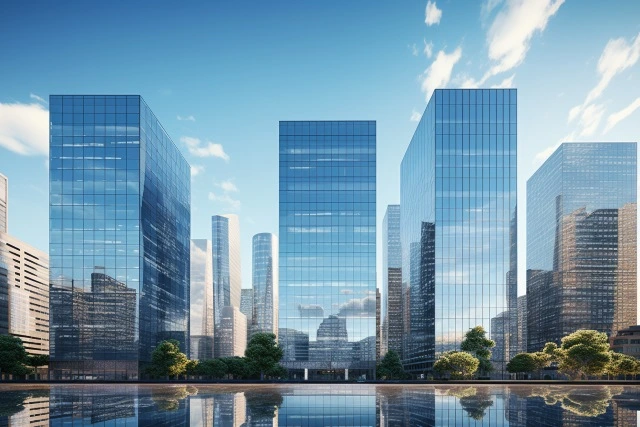Effective property management can distinguish between a thriving business hub and a vacant building. It’s the difference between running a property with a neverending barrage of complaints and delighted tenants. But it’s a lot more than just a routine checklist. It’s an art that balances the immediate needs of a building with the long-term strategic vision for its growth. That’s why most rental property owners use a property manager, according to a Business Wire survey.
What is commercial property management and the basics?
Commercial property management is a multifaceted discipline that involves the oversight, control, and operation of real estate intended for business use. It encompasses many functions, from the property’s day-to-day operations to the long-term strategic planning required to maintain and enhance its value. Key responsibilities within commercial property management include:
- Lease management and administration: Handling lease negotiations, renewals, and enforcement of lease terms.
- Financial oversight: Managing budgets, rent collection, expense payments, and financial reporting.
- Maintenance and repairs: Ensure the property is in good repair, manage routine maintenance, and respond to emergency maintenance issues.
- Tenant relations: Serving as the point of contact for tenant concerns, facilitating communication, and fostering a positive relationship between tenants and the property owner.
The goals of a property manager
A commercial property manager aims to achieve several key objectives:
- Maximize financial performance: Increase the property’s net operating income through efficient operations, effective leasing strategies, and prudent financial management.
- Enhance property value: Find opportunities to boost market value with cost-effective improvements and effective space management.
- Ensure tenant satisfaction: Keeping tenants happy and engaged helps retain them and maintain a high occupancy rate.
- Comply with relevant laws and regulations: Ensure the property adheres to all applicable local, state, and federal regulations, avoiding legal issues and fines.
Why effective commercial property management matters
Managing commercial properties effectively is essential for tenant retention, financial stability, and long-term value growth. Poorly managed buildings face higher vacancy rates, legal risks, and unexpected maintenance costs, making structured property management necessary.
Key benefits of well-managed commercial properties:
Higher occupancy rates
Well-maintained properties and proactive lease management increase tenant retention and reduce vacancies. According to a CBRE report, strong property management strategies have led to rising occupancy rates in premium office spaces.
Tenant satisfaction & retention
Tenants today prioritize building quality, energy efficiency, and digital amenities when deciding whether to renew leases. A JLL report highlights that modernized buildings have significantly higher tenant interest than outdated spaces.
Cost control & sustainability
With increasing energy efficiency and sustainability regulations, data-driven property management helps landlords cut energy costs, comply with environmental laws, and attract ESG-conscious tenants.
The risks of poor property management
- Higher vacancy rates & tenant churn
- Increased maintenance costs due to reactive instead of preventative repairs
- Legal & compliance penalties from regulatory violations
The solution? Data-driven platforms like ProptechOS help property owners streamline operations, automate lease management, and track building performance in real-time, ensuring optimized tenant experience and cost efficiency.
Understanding target audiences and roles in commercial property management
Understanding the target audience is crucial for tailoring properties to meet specific needs and expectations. Different types of commercial buildings serve different purposes, and the property manager’s role is to ensure that each property is optimized for its intended audience. This involves:
- Market research: Keeping up-to-date on the latest working preferences in the industries your commercial properties serve.
- Customization: Adapting spaces to meet your building’s occupant dynamics, which may involve renovations, technological upgrades, or changes in service offerings.
- Tenant mix strategy: Selecting the right blend of tenants to create a synergistic environment that benefits all parties and draws in the target audience.
- Feedback loops: Establishing channels for receiving feedback from tenants and visitors to continuously improve the property’s appeal and functionality.
How to best manage commercial property on a portfolio level
Managing commercial properties effectively requires a strategic approach that balances day-to-day operations with long-term portfolio performance. Whether overseeing a single building or a diverse real estate portfolio, property owners can benefit from expert property managers and data-driven decision-making.
1. Lease & tenant management
- Screen and secure high-quality tenants: Conduct background checks and ensure lease terms align with financial stability and occupancy goals.
- Optimize lease agreements: Structure leases for long-term revenue stability, reducing churn and securing reliable income.
- Enhance tenant experience: Foster communication, proactively address tenant needs, and implement smart technology to improve engagement.
2. Financial planning & risk mitigation
- Monitor key performance indicators (KPIs): Track Net Operating Income (NOI), rent collection, and maintenance costs to measure profitability.
- Implement cost-saving measures: Use predictive maintenance and energy-efficient solutions to minimize operating costs.
- Diversify revenue streams: Leverage co-working spaces, flexible leases, and premium amenities to maximize returns.
3. Maintenance & facility management
- Use IoT & Smart monitoring: Install real-time monitoring systems for maintenance tracking and early issue detection.
- Preventative maintenance strategy: Schedule regular inspections and predictive servicing to reduce costly breakdowns.
- Sustainability & compliance: Ensure properties meet energy efficiency standards and local regulations to maintain asset value.
4. Data-Driven Decision Making
- Use portfolio management software: Modern dashboard solutions provide real-time insights into occupancy rates, rental income, and operational costs.
- Optimize asset value with AI-powered apps: Platforms like ProptechOS analyze data patterns to improve decision-making and automate processes.
- Scale operations efficiently: Centralized data allows property owners to track multiple properties without stretching resources too thin.
Traditional vs. Smart Property Management with ProptechOS
| Feature | Traditional Management | Smart Property Management (ProptechOS) |
| System Integration | Buildings locked into separate, non-communicating systems (BMS, energy, access control). | Unified integration layer that connects multiple data sources (IoT, BMS, BIM, Energy Management, and Digital Twins) into a single operational view. |
| Data & Insights | Fragmented data across multiple vendor platforms. Manual reports with limited real-time insights. | Real-time dashboards & predictive analytics, aggregating data from all sources for a comprehensive, live view. |
| Tenant Experience | Hard to optimize occupancy and space utilization due to disconnected data sources. | Uses presence & occupancy data to improve space efficiency and tenant comfort. |
| Cost Efficiency | Higher operational costs due to redundant systems and reactive maintenance. | Predictive maintenance & automation reduce downtime and cut costs by optimizing energy usage and repair schedules. |
| Scalability & Future-Proofing | Expansion is costly and complex due to vendor lock-in and system incompatibility. | Built on an open standard (RealEstateCore), allowing seamless expansion and adaptability as portfolios grow. |
Why switch to ProptechOS?
Unlike traditional systems where each building has its own vendor lock-in, ProptechOS sits on top of existing infrastructure—acting as an integration layer that connects every system, sensor, and platform into one smart ecosystem.

Dr. Erik Wallin
Chief Ecosystem Officer, and founder of ProptechOS and RealEstateCore is recognized as a leader in Building Operating Systems (BOS) and making the buildings of the world smarter. He holds an MSc and a Ph.D. in Media and Computer Science from KTH Royal Institute of Technology.
Read his full bio and information here.


